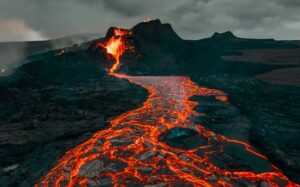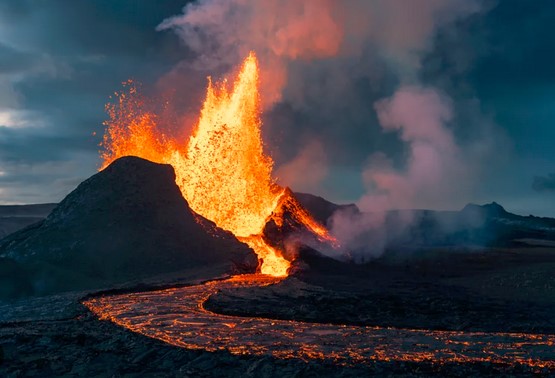Volcanoes, both awe-inspiring and formidable, have fascinated humanity for centuries. These geological marvels, often associated with destruction, are also key to the Earth’s dynamic processes. In this article, we will delve into the world of volcanoes, exploring their formation, types, eruptive behaviors, and the significant impact they have on our planet.

Volcano Formation
Volcanoes form when molten rock, known as magma, rises from the Earth’s mantle to the surface. This molten material can originate from several sources, including the partial melting of the Earth’s crust and mantle or from deep within the mantle itself.
Types of Volcanoes:
- Shield Volcanoes: These are broad, gently sloping volcanoes characterized by relatively non-explosive eruptions. Mauna Loa and Mauna Kea in Hawaii are classic examples.
- Stratovolcanoes (Composite Volcanoes): Stratovolcanoes are steeper, cone-shaped mountains formed by alternating layers of lava flows, ash, and volcanic rocks. Mount St. Helens and Mount Fuji fall into this category.
- Cinder Cone Volcanoes: Cinder cones are small, steep-sided volcanoes formed by the accumulation of volcanic debris, such as ash, cinders, and volcanic rocks. Paricutin in Mexico is a famous cinder cone.
Volcanic Eruptions:
- Explosive Eruptions: These eruptions are characterized by the violent release of gas, ash, and volcanic rocks. Explosive eruptions often result from the interaction of magma with water or gas buildup within the magma chamber. They can be catastrophic and have far-reaching impacts on the environment and climate.
- Effusive Eruptions: Effusive eruptions involve the relatively quiet outflow of lava. These eruptions tend to be less explosive and result in the gradual buildup of lava flows. Effusive eruptions are commonly observed at shield volcanoes.
Volcanic Hazards:
- Lava Flows: Although relatively slow-moving, lava flows can cause damage to property and infrastructure. Cooler lava flows can solidify quickly, while hotter lava can continue to flow for extended periods.
- Pyroclastic Flows: These are high-speed, superheated flows of gas, ash, and volcanic rocks. Pyroclastic flows are extremely deadly and can reach speeds of hundreds of kilometers per hour.
- Ashfall: Volcanic ash can blanket large areas, disrupting transportation, damaging crops, and posing health risks to humans and animals.
- Lahars: Lahars are fast-moving mudflows or debris flows triggered by volcanic activity. They can result from the melting of snow and ice on the volcano during an eruption.
Volcanoes and Earth’s Climate:
Volcanic eruptions can have a significant impact on the Earth’s climate. Massive eruptions can inject large amounts of sulfur dioxide (SO2) and ash into the stratosphere. The sulfur dioxide combines with water vapor to form sulfuric acid aerosols, which reflect sunlight back into space. This can lead to a temporary cooling effect on the planet, often referred to as a “volcanic winter.”
Notable Volcanoes in History:
- Mount Vesuvius: This infamous Italian volcano famously destroyed the ancient city of Pompeii in 79 AD, preserving a snapshot of life in Roman times.
- Krakatoa: The eruption of Krakatoa in 1883 was one of the most powerful in recorded history, causing tsunamis and a global drop in temperatures.
- Mount Tambora: The eruption of Mount Tambora in Indonesia in 1815 is known as the most powerful volcanic eruption in modern history. It resulted in the “Year Without a Summer” in 1816.
Conclusion
Volcanoes are powerful reminders of the dynamic nature of our planet. While they pose significant hazards, they also play a crucial role in shaping the Earth’s landscape and influencing its climate. Understanding the science behind volcanoes helps us mitigate the risks they present and appreciate their importance in the ongoing story of our planet’s geological evolution.




